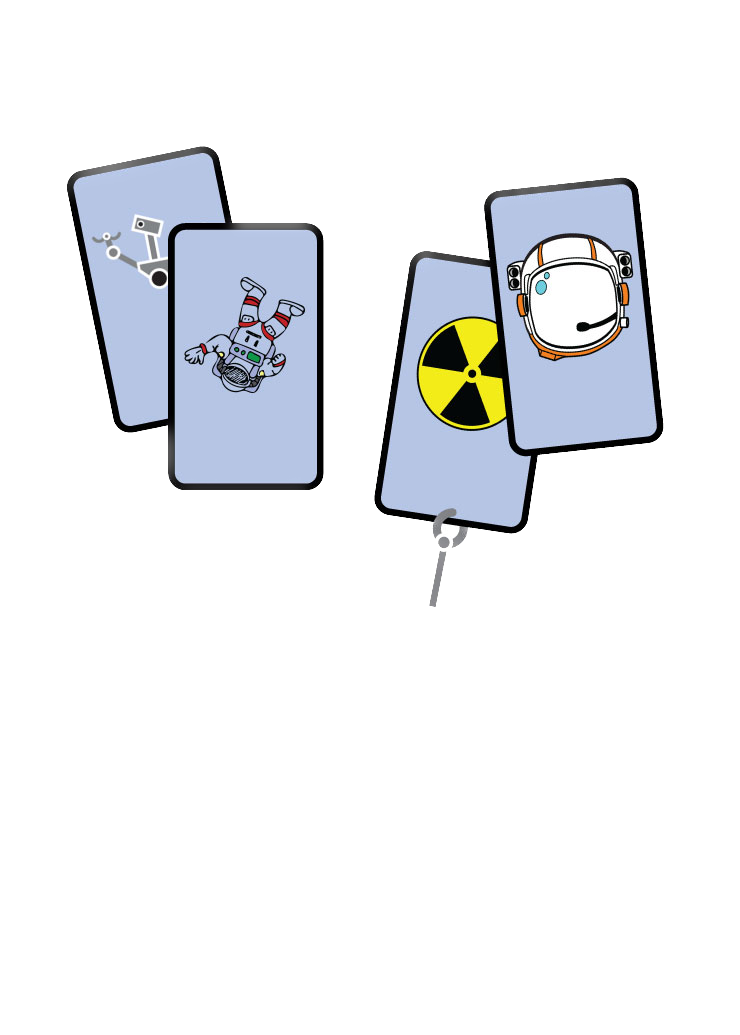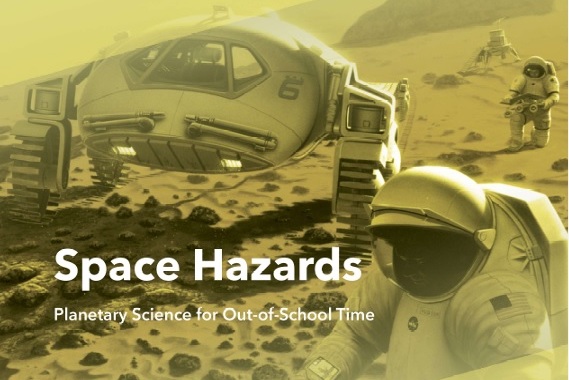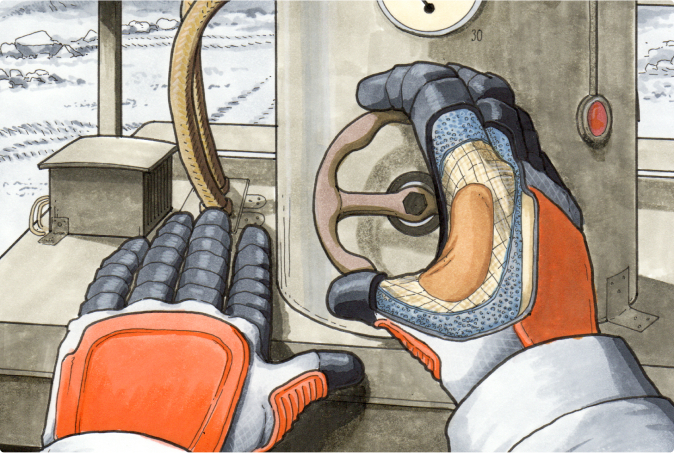
Discovering planetary data from Earth: how science and engineering can help us learn about the solar system!
Develop a plan to mitigate hazards on a NASA mission and engineer space gloves to protect astronauts from cold, impact, and dust!

How to Teach These Units
Chilling Out
Youth explore how well different materials insulate against cold.
Youth Will Know
- A space glove must protect astronauts from extreme temperatures in space.
- Some materials are better than others at protecting against the cold.
Activity Downloads
|
A2_Chilling_Out_Educator_Guide
Chilling Out Educator Guide
|
|
|
A2_Chilling_Out_Engineering_Journal
Chilling Out Engineering Journal (English)
|
|
|
A2_Chilling_Out_Engineering_Journal_Spanish
Chilling Out Engineering Journal (Spanish)
|
Setup
The Educator Guide has a script, materials list, and prep directions. Be sure to have it open and ready to help guide you through every activity. It will take about 30 minutes to prepare for this activity.
- Post the EDP Poster.
- Get the Message from the Duo ready.
- Transcribe Testing Results.
- Set up the Materials Table.
- Cut two model hands (Educator Guide p. 41).
- Set aside 2 bags for demo.
- Review Cold Test Procedure (Educator Guide p. 40).
- Set up testing stations (6 cups ice, 10 cups water, digital thermometers, cardboard hands, stop watches).
Guiding Question
Which materials are good at protecting against cold?
Youth Will Do
- Test and compare different materials to see which ones work best to protect against cold temperatures.
Did You Know?
Outside the space station temperatures are 120C (250F) in the sun, and -155C (-250F) in the shade. Space suits have water circulating through to help with the extreme temperatures.
Quick Tips
- Group management strategies:
- Make bold labels for Materials Table.
- Make bags of materials for each group rather than a Materials Table.
- Rotate groups through stations.
- Designate a volunteer to help other groups with testing and reset.
- Use the cardboard model hand so that your warm-blooded hand does not affect the thermometer reading.
Glossary
Insulator: a material that does not allow heat to move through it quickly
Audio
Related Videos
Activity Timing
Mitigate Hazards for Your Mission
Youth investigate the hazards and mitigations that apply to a specific mission and learn that hazards and mitigations differ for human and robotic missions.
Youth Will Know
- Some hazards are different between Earth, Moon, Mars, and asteroids, and some are the same.
- Human and robotic missions must mitigate different hazards.
- Different types of missions have different hazards.
Activity Downloads
|
S4_Mitigate_Hazards_for_Your_Mission_Educator_Guide
Mitigate Hazards Educator Guide
|
|
|
S4_Mitigate_Hazards_for_Your_Mission_Science_Notebook
Mitigate Hazards Science Notebook
|
Setup
The Educator Guide has a script, materials list, and prep directions. Be sure to have it open and ready to help guide you through every activity.
- Combine Decks B, C, and D for each group.
Guiding Questions
- Which hazards do you think are the most/least likely for your particular mission?
- Which do you think are the most and least dangerous?
- Which mitigations do you think are the easiest, most cost effective, or apply to the most hazards?
Youth Will Do
- Choose one of four proposed NASA missions and present what hazards, mitigation strategies, and other factors NASA needs to consider and employ. The missions youth are considering are both human and robotic. They launch on Earth and visit the Moon, Mars, or asteroids.
Did You Know?
- NASA designs suits differently for some missions. For the Moon, space gloves have adjustable pressure to make manipulation easier. Engineers are designing a space glove to allow for control of a drone on Mars.
- Bonus: NASA has 200 different missions listed on their website.
Quick Tips
- This long activity can be split into two 30 minute activities:
- Part 1: Intro, Assign Mission, ID Hazards
- Part 2: Presentation Prep, Share Out, Reflect
- Many cards apply to each mission. Youth can choose which to focus on.
Glossary
Apollo Missions: The Apollo Program was a series of space missions designed to land humans on the Moon and bring them safely back to Earth. It was mostly active from the 1960s – 1970s. We're still analyzing data and samples from the Apollo missions!
Related Videos
Activity Timing
Hazards in Space
Youth explore different hazards and mitigations in space and learn that some are the same as they are on Earth.
Youth Will Know
- Hazards can be the same or different between Earth and space.
- Hazards can be the same or different between the Moon, Mars, and asteroids.
- Human have developed ways to mitigate some hazards in space.
Activity Downloads
|
S3_Hazards_in_Space_Educator_Guide
Hazards in Space Educator Guide
|
|
|
S3_Hazards_in_Space_Science_Notebook
Hazards in Space Science Notebook
|
|
|
Space-Hazards-Science-Mitigate-Hazards-Cards-and-Game-Board
Mitigate Hazards Cards and Game Board
|
Setup
The Educator Guide has a script, materials list, and prep directions. Be sure to have it open and ready to help guide you through every activity.
- Reuse Mitigate Hazards Playmats.
- Sort out Deck C from last activity.
- Print Deck D for each group of 4.
- Cut Deck D cards out and combine Decks C and D.
- Post the Game Rules.
- Have the S3 directions and educator background on hand.
Guiding Questions
- What are some of the hazards that NASA missions must mitigate in space in order to explore?
- What are some things NASA has done or people could do to mitigate these hazards?
- Do you think different places in space have different hazards?
Youth Will Do
- Match mitigation strategies with hazards in the same collaborative card fame as Activity 1, with different cards.
Did You Know?
Finding ways to mitigate hazards in space can improve life on Earth. For example, scientists studying bone loss prevention in space can help prevent bone loss for people with osteoporosis on Earth.
Quick Tips
If groups finish early, remove the Reasearch and Teamwork Chance cards and two to four mitigation cards from the deck and restart game play. This will make the game more challenging.
Glossary
- Gravity: A force that attracts 2 objects toward each other, such as the earth and all objects around it.
- Radiation: Energy in the form of light waves or particles.
Related Videos
Activity Timing
Space Hazards Game

Play the game and level up!
Space Hazards Game Materials
|
Space Hazards Game – Letter to Families
Letter to Families
|
|
|
Space_Hazards_Game_Instructions
Space Hazards Game Instructions
|
|
|
Space_Hazards_Game_Cards
Space Hazards Game Cards
|
|
|
Space_Hazards_Game_Board
Space Hazards Game Board
|
Space Hazards Videos
Space Hazards
Develop a plan to mitigate hazards on a NASA mission and engineer space gloves to protect astronauts from cold, impact, and dust!
Space Hazards: Planetary Learning for Out of School Time
In Good Hands: Engineering Space Gloves
How to Teach These Units
Space Hazards Game
Hazards on Earth
Youth are introduced to natural hazards and mitigations on Earth through a card matching game.

Youth Will Know
- There are different hazards on Earth.
- Humans have developed ways to mitigate hazards.
Activity Downloads
|
S2_Hazards_on_Earth_Educator_Guide
Hazards on Earth Educator Guide
|
|
|
S2_Hazards_on_Earth_Science_Notebook
Hazards on Earth Science Notebook
|
|
|
Space-Hazards-Science-Mitigate-Hazards-Cards-and-Game-Board
Mitigate Hazards Cards and Game Board
|
Setup
The Educator Guide has a script, materials list, and prep directions. Be sure to have it open and ready to help guide you through every activity.
- Print and tape together Mitigate Hazards playmats.
- Print and cut out Decks C and D for each group of 4.
- Post the Game Rules.
- Have the Educator Guide on hand for S2 directions and script.
Guiding Questions
- What are some examples of natural hazards?
- What are some things people could do to mitigate hazards?
Youth Will Do
- Learn about hazards on Earth and the idea that humans have developed ways to mitigate some of them.
- Match appropriate mitigation strategies with their hazards in a collaborative card game.
- Learn in the card game that chance events and human collaboration also play a role in hazard mitigation.
Did you know?
Some natural disasters can cause other natural disasters. For instance, an earthquake can trigger a landslide, or a volcano could set off a wildfire.
Quick Tips
- Don’t skip the Chance card actions; youth might respond better to kinesthetic and sensory learning than visual and auditory methods.
- If groups finish early, remove the Reaseach and Teamwork caards and two to four mitigation cards from the deck and restart gameplay.
Glossary
Natural Hazard: an extreme event that occurs naturally and can cause harm to humans or property
Related Videos
Activity Timing
Everyday Hazards
Youth play a matching card game to introduce the concepts of hazards as dangers and mitigation as a way to lessen the danger.

Youth Will Know
- Humans have developed ways to mitigate safety hazards.
Activity Downloads
|
S1_Everyday_Hazards_Educator_Guide
Everyday Hazards Educator Guide
|
|
|
S1_Everyday_Hazards_Science_Notebook
Everyday Hazards Science Notebook
|
|
|
Space-Hazards-Science-Safety-Cards-and-Game-Board
Mitigate Hazards Cards and Game Board
|
Setup
The Educator Guide has a script, materials list, and prep directions. Be sure to have it open and ready to help guide you through every activity.
- Read through the Science Guide.
- Print Science Notebooks for youth.
- Print and tape together Safety Hazards playmats.
- Print and cut out Deck A for each group of 4.
- Post the Game Rules.
- Have the Educator Guide on hand for S1 directions and script.
Guiding Questions
- What are some examples of everyday hazards?
- What are some safety tips that help address these hazards?
- What does the word "mitigate" mean?
- What does a Health and Safety Officer do?
Youth Will Do
- Learn about the concept of hazards and the idea that humans have developed ways to mitigate some of them.
- Act out hazards and safety tips in a form of charades and match appropriate safety tips with their respective hazards in a collaborative card game.
- Learn the definition of the word “mitigate” and be introduced to the idea that there are careers focused on hazard mitigation.
Did you know?
- Most if not all mitigation strategies can be considered technologies since technology is anything designed by humans to help solve a problem. Check out Engineering Preparation Activity 2: What is Technology? Hands-On Technology to learn more.
- Many industries have Health and Safety Officers (HSOs). In construction, the HSO must write a plan that identifies all known hazards and how to mitigate them. These often include hazards like frostbite or bee stings.
Quick Tips
- Define both "hazard" and "mitigate" as a group.
- Pay extra attention to the group that is dealt the hazard card for Tripping and make sure youth are planning on acting it out in a safe way.
Glossary
- Hazard: a source of danger
- Mitigate: to make less severe, serious, or painful


